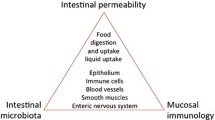Abstract
This study evaluated the healing property, on colonic anastomoses, of a new compound termed RGTA11 (standing for “regenerating agent,” a dextran derivative with heparin-like properties). Colonic anastomoses were performed in 183 adult rats after dipping both ends of the colon in solutions containing RGTA11. The anastomoses were made end-to-end on a single plan, 8 sutures. Heal-ing was evaluated mechanically by the bursting pressure in 108 animals and histological analysis in 75. Results indicated that after 48 h RGTA11-treated animals presented a twofold increased resistance to anastomoses breakage (P<0.01) over nontreated (saline buffer) animals. After 96 h and until day 7 there was no longer a difference be-tween study and control animals. Although this difference in breakage was not readily observed at histological level, results suggest that RGTA11 could be used to aid colonic anastomosis healing. RGTA11 is of potential clinical interest in this regard since complications that are known to occur postoperatively result from early leakage.
Résumé
Afin d'évaluer l'effet sur la cicatrisation d'anastomose colique d'une nouvelle substance nommée RGTA11 (agent régénérant, un dérivé du dextrane avec des propriétés de type héparinique), les expériences suivantes ont été entreprises: Cent-quatre-vingt-trois anastomoses coliques ont été réalisées chez le rat après avoir immergé les deux extrémités du côlon dans une solution de RGTA11. Des anastomoses ont été faites à la main de manière termino-terminale en un seul temps avec 8 points de suture. La guérison a étéévaluée mécaniquement en mesurant la pression de rupture chez 108 animaux et en procédant à une analyse histologique chez 75. Les résultats indiquent qu'après 48 heures, les animaux traités par RGTA11 présentent une résistance à la rupture de l'anastomose deux fois supérieure (P<0,01) comparativement aux animaux non traités (solution saline). Après 96 heures et jusqu'au 7e jour, il n'y a pas d'augmentation de la différence entre les sujets étudiés et le groupe-contrôle. Bien que la différence dans la fragilité n'ait pas été observée à un niveau histologique, nos résultats suggèrent que RGTA11 pourrait ëtre utilisé pour favoriser la guérison des anastomoses coliques. RGTA11 est donc potentiellement intéressant pour favoriser la guérison des anastomoses coliques étant donné que les complications survenant dans la période post-opératoire résultent de fuites anastomotiques précoces.
Similar content being viewed by others
Author information
Authors and Affiliations
Additional information
Accepted: 21 November 1997
Rights and permissions
About this article
Cite this article
Benoit, J., Meddahi, A., Ayoub, N. et al. New healing agent for colonic anastomosis. Int J Colorect Dis 13, 78–81 (1998). https://doi.org/10.1007/s003840050139
Issue Date:
DOI: https://doi.org/10.1007/s003840050139




